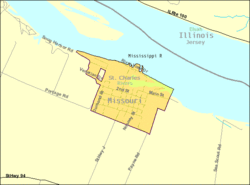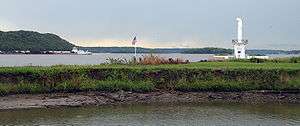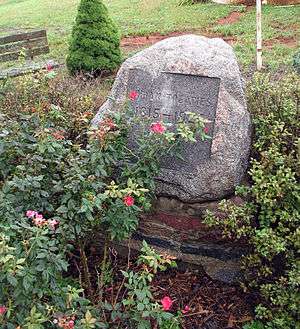Portage Des Sioux, Missouri
| Portage Des Sioux, Missouri | |
|---|---|
| City | |
 Location of Portage Des Sioux, Missouri | |
 U.S. Census Map | |
| Coordinates: 38°55′35″N 90°20′35″W / 38.92639°N 90.34306°WCoordinates: 38°55′35″N 90°20′35″W / 38.92639°N 90.34306°W | |
| Country | United States |
| State | Missouri |
| County | St. Charles |
| Area[1] | |
| • Total | 0.53 sq mi (1.37 km2) |
| • Land | 0.45 sq mi (1.17 km2) |
| • Water | 0.08 sq mi (0.21 km2) |
| Elevation | 433 ft (132 m) |
| Population (2010)[2] | |
| • Total | 328 |
| • Estimate (2012[3]) | 329 |
| • Density | 728.9/sq mi (281.4/km2) |
| Time zone | Central (CST) (UTC-6) |
| • Summer (DST) | CDT (UTC-5) |
| FIPS code | 29-59150[4] |
| GNIS feature ID | 0756547[5] |


Portage Des Sioux is a city in St. Charles County, Missouri, United States. The town sits on the Mississippi River roughly opposite Elsah, Illinois, and is the home of the riverside shrine of Our Lady of the Rivers. The population was 328 at the 2010 census. The city was founded in 1799 by Spanish Lt. Gov. Zenon Trudeau and François Saucier in reaction to American plans to build a military post about twelve miles (19 km) downstream. The French name derives from the overland escape route between the Missouri River and Mississippi River used by a band of Sioux, fleeing enemies; they used this area as a portage for their canoes,[6] outdistancing their rivals who instead paddled all of the way to the confluence of the rivers.
The Treaties of Portage des Sioux in 1815 were signed here ostensibly settling Native American and United States conflicts in the War of 1812. The treaties consolidated affirmed the Treaty of St. Louis (1804) in which the Sac and Fox ceding northeast Missouri and much of Illinois and Wisconsin and the 1808 Treaty of Fort Clark in which the Osage Nation ceded all of Missouri and Arkansas. These treaties were to ultimately, result in the Black Hawk War and the tribes being forced to move west of Missouri.
Portage Des Sioux was also one of the main film sites for the TV reality show on the CW a Farmer Wants a Wife (the farmer in the 2008 season, also lives in Portage Des Sioux).
Geography
Portage Des Sioux is located at 38°55′35″N 90°20′35″W / 38.92639°N 90.34306°W (38.926348, -90.342982).[7]
According to the United States Census Bureau, the city has a total area of 0.53 square miles (1.37 km2), of which, 0.45 square miles (1.17 km2) is land and 0.08 square miles (0.21 km2) is water.[1]
Demographics
| Historical population | |||
|---|---|---|---|
| Census | Pop. | %± | |
| 1860 | 98 | — | |
| 1870 | 160 | 63.3% | |
| 1880 | 225 | 40.6% | |
| 1900 | 242 | — | |
| 1910 | 218 | −9.9% | |
| 1920 | 283 | 29.8% | |
| 1930 | 248 | −12.4% | |
| 1940 | 254 | 2.4% | |
| 1950 | 264 | 3.9% | |
| 1960 | 371 | 40.5% | |
| 1970 | 509 | 37.2% | |
| 1980 | 488 | −4.1% | |
| 1990 | 503 | 3.1% | |
| 2000 | 351 | −30.2% | |
| 2010 | 328 | −6.6% | |
| Est. 2015 | 332 | [8] | 1.2% |
As of 2000 the median income for a household in the city was $38,333, and the median income for a family was $42,321. Males had a median income of $41,875 versus $25,000 for females. The per capita income for the city was $18,693. About 2.8% of families and 2.3% of the population were below the poverty line, including 4.0% of those under age 18 and none of those age 65 or over.
2010 census
As of the census[2] of 2010, there were 328 people, 136 households, and 90 families residing in the city. The population density was 728.9 inhabitants per square mile (281.4/km2). There were 166 housing units at an average density of 368.9 per square mile (142.4/km2). The racial makeup of the city was 98.5% White, 0.6% from other races, and 0.9% from two or more races. Hispanic or Latino of any race were 1.8% of the population.
There were 136 households of which 28.7% had children under the age of 18 living with them, 52.2% were married couples living together, 7.4% had a female householder with no husband present, 6.6% had a male householder with no wife present, and 33.8% were non-families. 31.6% of all households were made up of individuals and 9.5% had someone living alone who was 65 years of age or older. The average household size was 2.41 and the average family size was 3.02.
The median age in the city was 44.3 years. 22% of residents were under the age of 18; 7.6% were between the ages of 18 and 24; 21.3% were from 25 to 44; 38.8% were from 45 to 64; and 10.4% were 65 years of age or older. The gender makeup of the city was 51.2% male and 48.8% female.
References
- 1 2 "US Gazetteer files 2010". United States Census Bureau. Retrieved 2012-07-08.
- 1 2 "American FactFinder". United States Census Bureau. Retrieved 2012-07-08.
- ↑ "Population Estimates". United States Census Bureau. Retrieved 2013-05-30.
- ↑ "American FactFinder". United States Census Bureau. Retrieved 2008-01-31.
- ↑ "US Board on Geographic Names". United States Geological Survey. 2007-10-25. Retrieved 2008-01-31.
- ↑ Eaton, David Wolfe (1918). How Missouri Counties, Towns and Streams Were Named. The State Historical Society of Missouri. p. 356.
- ↑ "US Gazetteer files: 2010, 2000, and 1990". United States Census Bureau. 2011-02-12. Retrieved 2011-04-23.
- ↑ "Annual Estimates of the Resident Population for Incorporated Places: April 1, 2010 to July 1, 2015". Retrieved July 2, 2016.
- ↑ "Census of Population and Housing". Census.gov. Retrieved June 4, 2015.
External links
- Our Lady of the Rivers Shrine
- Blessing of the Fleet in Portage des Sioux
- Rivers Pointe Fire Protection District
- Our Lady of the Rivers
- St. Charles City-County Library District
